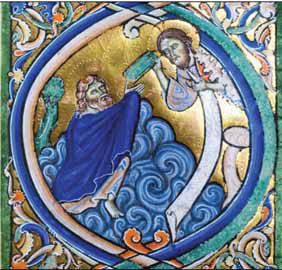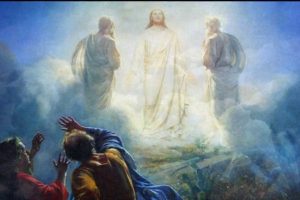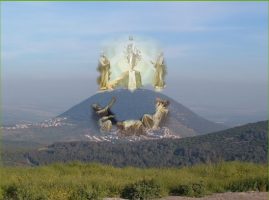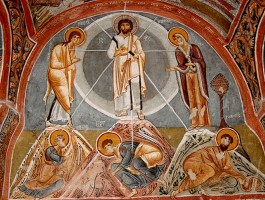The Transfiguration is at the very heart of Christian theology, irresistibly commanding the gaze of the iconographer, the ready pen of the hymnographer, the amazing tales of the hagiographer, and constituting, one can say, the focal point of the Orthodox Church’s “mystical theology.” Much of early Christian exegesis uses the Transfiguration account as a springboard for spiritual rumination.
Thus the glory of the Transfiguration discloses Christ’s divine identity, so that even when we behold the Crucified One we should not forget that He is the Lord of glory (1 Corinthians 2:8); the luminous vestments of the Lord represent the many layers of his divine and human reality, as disclosed to us in the many layers of the Scriptures; the blinding appearance of the Transfigured One sets before us the image of our glorified state in the age to come; the Taboric light is the deifying divine energy, that is, God-as-He-manifests-Himself. This approach, exemplified by Origen, St. Maximus the Confessor, or St. Gregory Palamas, is generally well-known. Indeed, many scholars (and many Orthodox theologians among them) have discussed the rich “reception history” that the Transfiguration account has had in patristic literature, East and West.
In what follows I will point to another strand of interpretation, which is much less explored in scholarship and somewhat muted in Church preaching. According to St. Irenaeus of Lyon, Tertullian, St. Anastasius the Sinaite, and the Byzantine hymnographic tradition, the Transfiguration account set forth in the Gospel of Matthew is not only a “vision” (Matthew 17:9) that the disciples have of Christ, but, so to speak, a vision of a vision: a vision granted to Moses and Elijah, witnessed by the disciples. This interpretation is ancient, going back to at least the second century; moreover, as its hymnographic and iconographic reception attests, this interpretation enjoyed unsurpassed popularity during the first Christian millennium.
The Vision on Tabor and the Vision on Sinai

Moses with the Lord on Sinai, receiving the Law. Winchester Bible folio 5r, 12th century; Photo by Dr.John Crook, Winchester
The connection between Tabor and Sinai is first and foremost suggested by the very readings assigned for the Vespers of the Transfiguration. To understand Christ’s appearance on Tabor, we read from Exodus 24 (the appearance of the Lord to the seventy elders on Sinai), Exodus 33 (of which more presently), and 3 Kingdoms/ 1 Kings 19 (Prophet Elijah’s vision on the Mountain of the Law).
In Exodus 33, in response to Moses’ request to see the divine glory more intimately, God states that He will indeed manifest Himself to his prophet by parading in his glory, by proclaiming the divine name, and by showing Moses His back parts. But God insists on the impossibility of a more complete revelation: “You shall not be able to see my Face, for no man shall see my Face and live …. You shall see my hind parts; but my Face will not appear to you (Exodus 33:20, 23). Some early Christians interpreted this to mean that the vision face to face, refused to Moses, was being postponed for a later time. The great theologian of the second century, for instance, St. Irenaeus of Lyon, writes in his treatise Against Heresies 4.20.9:
[The passage in Exodus 33] signifies two things, namely that it is impossible for man to see God, and that man will see Him in the latter times on the summit of the rock, thanks to God’s Wisdom: that is in His coming as man. And it is for this reason that he conferred with him face to face on the top of the mountain [at Transfiguration], while Elijah was also present (as the Gospel relates), thus fulfilling in the end the ancient promise.
For Tertullian also (Against Praxeas 14.7), who writes a few decades later, a more perfect vision of the Face of God – that is, of the Son – than was available on Sinai was reserved for Moses’ vision on Tabor:
He reserves to some future time his presence and speech face to face with Moses – for this was afterwards fulfilled in the retirement of the mount [of Transfiguration], as we read in the Gospel, “Moses appeared, talking with him.”
This type of exegetical linking of Sinai and Tabor carries on in later orations and hymns of the Transfiguration. St. Anastasius of Sinai, the seventh-century holy abbot of Saint Catherine’s Monastery on Sinai, exploits the occurrence of “vision” in the Transfiguration account (Matthew 17:9) and “great vision” at the burning bush (Exodus 3:3), and then very explicitly identifies Christ as the subject of both the revelation at Sinai and of that at Tabor:
Now I have seen You, The-One-Who-Truly-Is …. You that said on the mountain, “I am He-Who-Is” [Exodus 3:14] .… I have seen You, whom of old I desired to see, saying, “show Yourself clearly to me” …. I have seen You, no longer as you revealed Your back and turned me away on the rock of Sinai, but as made visible to me clearly on the rock of Tabor.
The same view is echoed by St. John of Damascus, whose compositions remain, to this day, part of the official Transfiguration hymnography of the Orthodox Church:
He who once spoke through symbols to Moses on Mount Sinai, saying, “I am He-who-is” [Exodus 3:14] was transfigured today upon Mount Tabor before the disciples . . . (Great Vespers of Transfi guration, Apostichon);
You were seen by Moses on the mountain of the Law and again on Tabor; formerly in the darkness but now in the unapproachable light of Godhead (Second Canon of Transfiguration: Ode 1, Sticheron 3).
The Vision of “He-Who-Is”
It is quite obvious, from the texts surveyed so far, that an important segment of patristic and Byzantine exegesis regards the Transfiguration not only as a vision that the disciples have of Christ, but, so to speak, as a vision of a vision: a vision that the disciples have of Moses and Elijah gazing on the transfigured Jesus, because they have gazed upon the same “Lord” before, on Sinai. This manner of reading the divine manifestation at Sinai was absorbed into Byzantine festal hymnography, thus becoming widespread and theologically normative. For instance, the hymnography of the Meeting (or Presentation) of the Lord, which we celebrate on February 2, is replete with statements about how the very Lawgiver, the One who thundered on Sinai, is now brought to the Temple:
Today Simeon takes in his arms the Lord of Glory whom Moses saw of old in the darkness, when on Mount Sinai he received the tables of the Law (Presentation of the Lord: Sticheron at the Litya);
Receive, O Simeon, Him whom Moses once beheld in darkness, granting the Law on Sinai, and who has now become a baby subject to the Law; yet this is the One who spoke through the law! (Great Vespers of the Presentation: Sticheron at Lord I have cried);
The Ancient of Days, who in times past gave Moses the Law on Sinai, appears this day as a baby. As Maker of the Law, He fulfills the Law, and according to the Law He is brought into the temple (Great Vespers of the Presentation: Sticheron at the Litya).
We see the same perspective in the hymns celebrating the Jordan Baptism. The Baptist is petrified with fear, because it is no less than the “Lord” revealed to Moses on Sinai who now condescends to be baptized:
Moses, when he came upon You, displayed the holy reverence that he felt: perceiving that it was Your voice that spoke from the bush, he forthwith turned away his gaze [Exodus 3:6]. How then shall I behold You openly? How shall I lay my hand upon You? (First Canon of Theophany: Ode 4 Sticheron);
If I baptize You, I shall have as my accusers the mountain that smoked with fire [Exodus 19:18], the sea which fled on either side, and this same Jordan which turned back [Psalm 113/114:5] (First Canon of Theophany: Ode 4 Sticheron).
This is surely not a marginal strand of interpretation: none of the Fathers has been read so extensively as these hymns have been (and continue to be) chanted, listened to, and called to mind by believers from almost all times and places, and with such unconditional acceptance. What is more, the witness of the hymns is confirmed by that of the icons, which often depict Moses on Sinai receiving the Law from the hand of the Lord Jesus Christ!
In short, the message seems to be the same as that of the hymns: Moses appears with Jesus on Tabor because He-Who-Is revealed Himself on Sinai! “He-Who-Is,” the self-designation of God at the burning bush (Exodus 3:14), is precisely the “definition” given of Christ in all icons – be it of the baby in the arms of the Theotokos, or the Lord as Teacher, or the Crucified, Risen, or Transfigured One. “He-Who-Is” (or, in a less felicitous rendering, “The Existing One”), Christ our Lord,” is precisely what we hear the priest proclaim at the closing of Vespers. It is this identification, after all, that lends weight to the earliest Christological proclamation: Jesus is “Lord”!
Hymns Are Theology
The hymns of the Church anchor all of us in the living experience of Israel’s walk with the God of Abraham, Isaac, and Jacob, the Lawgiver and “God of our fathers” – the same one whom the hymns proclaim as Jesus Christ, the Lord. There is no need to argue for the importance of the hymns in Christian devotion – this is quite self-evident. But it is worth repeating that, in the Orthodox Church, hymnography can never be isolated from doctrinal inquiry: hymns are theology, and they ought to be taken seriously by all who wish to acquire the mind of the Church. They are bearers of an elaborate Christology, which essentially proclaims the same mystery of Christ that the ecumenical councils sought to defend, yet in a language very different from that of conciliar definitions.
Learning theology from the hymns not only teaches us but also shapes our religious awareness. The Troparion of the Transfiguration – “You were transfigured on the mountain, O Christ God, revealing Your glory to Your disciples as far as they could bear it. Let Your everlasting Light also shine upon us sinners …” – is not about some past event, but about the “body of the Lord” that we must learn to discern (1 Corinthians 11:17) when called to approach the chalice “with fear of God, faith, and love.” We are called to draw near the Lord, the very Lord who spoke on Sinai, so that we may partake of the same vision as Moses, the Apostles, and all the saints, and join in their confession: we have seen the true light, we have received the heavenly Kingdom!
Bogdan Gabriel Bucur is a member of the community at St. George Orthodox Cathedral in Pittsburgh. He is also an assistant professor of Theology at Duquesne University, where he teaches Bible and Patristics.
Source: The Word, Volume 54, No 6, June
You might also like
















